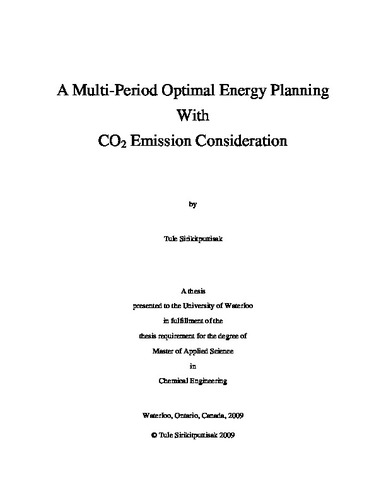| dc.description.abstract | A multi-period optimal energy planning program for Ontario has been developed in mixed-integer non-linear programming using General Algebraic Modeling System, GAMS. The program applies both time-dependent and time-independent constraints. These include, but not limited to, construction time, fluctuation of fuel prices, and CO2 emission reduction target. It also offer flexibility of fuel balancing and fuel switching of the existing boilers and option purchasing of Carbon credit if the reduction target is not achievable. The objective function incorporates all these constraints as well as minimizes over all the cost of electricity and meets the projected electricity demand over the 30 years horizon.
A number of Ontario study cases are performed utilizing this 30 years model. These cases include a number of CO2 emission reduction target from 6% to 75% below that of 1990 levels by 2014, doubling of natural gas over the forecasted price in 2020, an arbitrary year. A study case in appliance with the Environmental Protection Act where no new or existing coal-fired power stations are available after 2014, as well as study cases where no new nuclear power stations are available.
The overall cost of the electricity for different CO2 emission reduction targets increases linearly with slope of ~ 5. The fuel switching, fuel balancing for coal stations, and retrofitting of the carbon capture and storage are the main strategy in order to keep the cost of electricity relative low and satisfy the CO2 emission constraints.
Nuclear power is an essential supply technology to the fleet especially when CO2 emission is concerned. An additional 248 Mt of CO2 emission is observed over the reference case when no new nuclear supply is offered. Eliminating all coal technologies by 2014 in accordance to the Environmental Protection Act may also reduce the CO2 emission with less additional expenditure normally associated with the emission reduction processes. This however also reduces the energy port folio diversity, forcing the system to depend on a smaller group of supply technologies and decreasing the reliability of the system overall.
These results help us better understand the factors affecting the fleet’s structure. It may also help plan the energy direction of Ontario and perhaps serve as an example for other provinces, territories, states, and even countries. | en |

